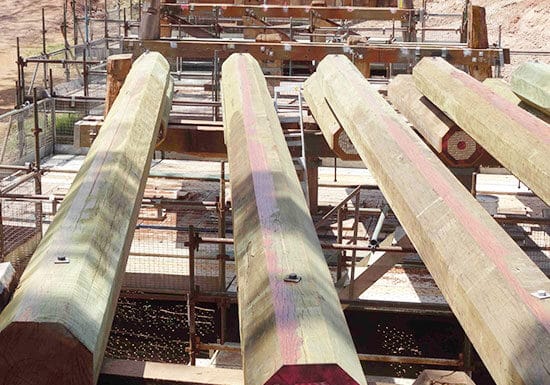
A heavy-duty bridge under construction in western New South Wales will span a river that is not yet there.
Only when the Goulburn River, near Mudgee, is diverted to pass under it will it be entitled to call itself a bridge?
In fact, the structure comprises twin concrete bridges only 150 mm apart, capable of carrying tremendous loads, supported on creosote-treated hardwood piles.
An unusual problem led to the use of pressure-impregnated timber pile foundations for the twin bridge system. The bridges are part of Ulan Col Mind Ltd’s open-cut mine development at Ulan near Mudgee.
An extremely high level of free carbon dioxide in the water in the underlying aquifers at the site ultimately precluded the use of the proposed reinforced concrete piling.
Free carbon dioxide reacts with free lime in the concrete matrix, and when conditions allow continual replenishment of the carbon dioxide, as was the case at this site, rapid deterioration and honey-combing of the exposed concrete element will occur.
The consulting engineers for the project, Macdonald Wagner and Priddle Pty Ltd, had noted that groundwater conditions were described as “aggressive” in the geotechnical reports. However, the reports failed to make clear the extent of the problem at Ulan.
Reference to the literature revealed that the site conditions encountered were beyond what codes normally consider high values for free carbon dioxide.
For example, the German Code DIN 4030 indicated a value of 50 mg/litre as extremely severe, and the Australian Cement and Concrete Association Bulletin TN37 recommended 15 mg/litre as the level where the concrete should be fully protected from the groundwater.
Values recorded at this site ranged from 80 to 190 mg/litre. To avoid the possibility of errors in sampling and testing, further groundwater samples were taken and tested. These confirmed the original results.
The location of the bridges was fixed by constraints of road geometry, access to coal loading facilities and river channel width. Therefore, it was not possible to select another site with more favourable foundation conditions.

Timber piling was initially suggested as a solution by the project’s geotechnical consultant Coffey and Partners Pty Ltd when the extent of the groundwater problem was confirmed.
Further investigations revealed that alternatives using reinforced concrete or structural steel piling might pose long-term maintenance and durability problems under groundwater conditions.
However, after pressure impregnation of chemicals, timber piling would not be affected by the groundwater and would not require any in-service maintenance.
After it was decided to adopt treated timber piling, Koppers, who supplied the piles, provided details of their use in various structures in the United States where they have been used since the 1930s.
While Koppers could not accurately predict a design life for the treated timber piles, they indicated that such piles had already been in service in many projects for up to 50 years.
For example, treated timbers used in a jetty in California in the 1930s were removed, and so little deterioration was found they were reused in California’s highway works. In this project, the design life of the mine and hence the bridges is only 30 years.
The twin bridges are designed to carry off-highway haul vehicles with a gross weight of 300 tonnes. Each pile was designed to carry a load of 65 tonnes.
However, extensive load testing indicated a potential load-carrying capacity for the timber piles in the range of 65-80 tonnes, which was equivalent to that anticipated for the concrete piles originally proposed.
Koppers supplied 178 treated timber piles for the bridges. They were a nominal diameter of 280 mm at the toe and were supplied about 11 m long.
Update 2023: NSW Roads and Maritime Services have finalised a strategy for the sustainable conservation of heritage timber truss bridges following stakeholder and community involvement.
Roads and Maritime manages 48 of the state’s 63 remaining timber truss bridges.
Built between about 1860 and 1936, the bridges represent an important part of the heritage of NSW, with 29 currently listed on the State Heritage Register.
Managing these historic assets into the future presents a significant challenge. Issues include load-carrying capacity, narrow bridge width, poor access and frequent and very expensive ongoing maintenance needs.






